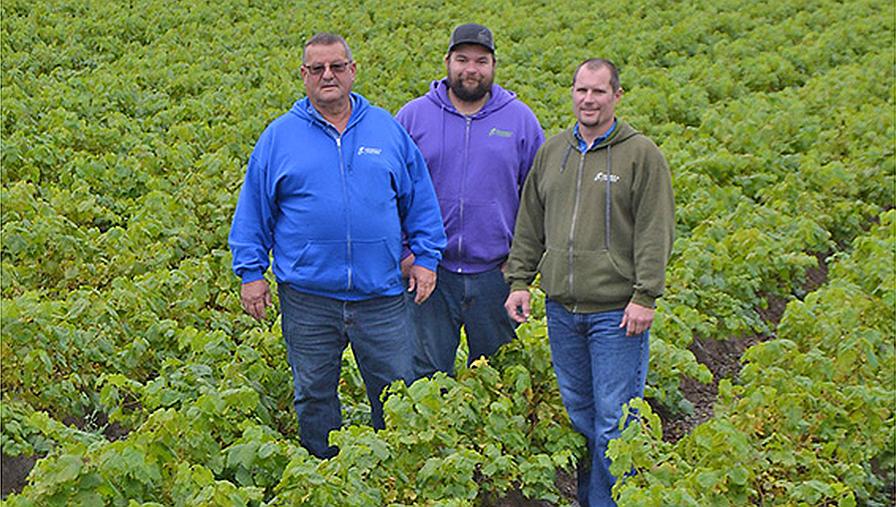This post was originally published on this site
Article Source: Great Grapevines On The Go With Double A Vineyards - Growing Produce

Dennis Rak’s dry-as-Sauvignon Blanc sense of humor comes over crystal clear when the grapevine nurseryman from New York state defines his client base. “We consider our market the East Coast — which is everything east of California, Washington, Oregon, and Idaho,” he says. Such a sweeping territory is good for business, Rak says. His family-owned operation, Double A Vineyards, competes with fellow nurseries from the East Coast as well as those from the West Coast.
“Our focus is to match the variety and the rootstock to the growing area that it is going to be in,” Rak says. “That’s where I think we do a good job.”
Established in 1990, Double A Vineyards sits about 4 miles off Lake Erie, south of Buffalo, in the village of Fredonia, NY. “Double A” refers to Dennis and wife Susan’s two sons: Adam Alexander and Abram Andrew (the former of which just had a baby boy named Aric Alexander).
Together, the Raks tend to 500 acres that rotate between nursery vines and grain crops and 450 acres of bearing vineyard, much of which accounts for 2,000 tons of ‘Concord’ grapes produced this season for Welch’s. Double A offers more than 150 varietals, ranging from Vitis vinifera to winter-hardy hybrid varieties, and handles between 4 and 5 million plantings annually.
Nursery customers include growers, wineries, mail-order companies, and wholesalers who repackage their vines for big-box retailers. Direct-to-consumer online sales have also attracted homeowners who desire a few vines in their backyard gardens.
“That’s a smaller volume but much higher margins,” Rak says. “We’ve been able to continue to grow that pretty steadily.”
HOT BEDS (AND COLD SPOTS)
Western states represented well by Double A include Colorado, New Mexico, Texas, and Oklahoma. The Atlantic seaboard is the fastest-growing region, specifically Virginia, North Carolina, Maryland, and New Jersey, Rak says. Meanwhile, business has tapered in the Midwest.
“There were some years when the cold-climate material was going pretty strong. Areas in the Midwest had high sales numbers,” Rak says. “But you went from an industry that didn’t exist, and, over a 20-year period, it’s in place now and just in a more mature space. Some of those cold-hardy varieties that came out of Minnesota, like ‘Frontenac’, ‘La Crescent’, and ‘Marquette’, we could basically sell anything we could grow. We’re not at that point anymore.”
DISEASE CREEP
Climate change is exacerbating the northerly spread of Pierce’s disease (PD), which in the eastern U.S. had largely been isolated to the Gulf Coast. Georgia, Arkansas, Virginia, and North Carolina are starting to see more of the bacterial disease if only because it is warmer, Rak says.
“If you get cold enough temperatures, it will beat it back. But if not, it just continues to get worse,” he says.
Double A has turned to varieties that have tolerance and resistance to PD, including five from Prof. M. Andrew Walker’s breeding program at University of California, Davis — ‘Camminare Noir’, ‘Paseante Noir’, ‘Errante Noir’, ‘Ambulo Blanc’, and ‘Caminante Blanc’. Also offered are PD-resistant varieties from Florida A&M, ‘Blanc Du Soleil’, and the University of Arkansas, ‘Southern Sensation Seedless’.
Downey mildew and powdery mildew round out the top three disease threats to grapevines. Through a license with California-based Novavine, Double A can sell mildew-resistant varieties propagated by the Italian nursery Vivai Cooperativi Rauscedo (VCR).
KILLER INSECT: LOOK OUT
Although there are no vines resistant to insects such as spotted lanternfly (SLF), Rak preaches diligence regarding the pest.
“Watch out … it’s coming … and be prepared to deal with it when it happens,” he advises. “When it got started there in southeastern Pennsylvania, it took out vineyards. They fed so much that it just killed them. Now, with monitoring and really, really aggressive spray programs, for the most part, growers seem to be able to keep ahead of it. But it is a potential big threat to the grape industry. We monitor it. We have traps in our fields.”
THE WEEDS/LABOR ISSUE
Rak’s strongest up-front advice for clients touches on a topic far too many discount — weed control.
“It’s very important for good weed control in young plantings, especially the first couple of years,” he says. “They put them out there and think, ‘Oh, I can keep ahead of the weeds,’ and before you know it, the weeds are three times as tall as the vines. Then there’s not really anything you can do but for manual labor, and that’s not good. You can’t find manual labor even if you did want to do it.”
With that in mind, Rak calls the reliance on the H-2A temporary agricultural program one of the “big changes” in the nursery industry. Double A’s production employees, which account for about 90% of the farm’s labor pool, now include about 30 H-2A employees from Mexico.
CLEAN PLANTS
Double A Vineyards joined the National Clean Plant Network (NCPN) and the New York State Grapevine Certification Program in 2015. Rak has no regrets.
“They sample 25% of our mother vines every year for a panel of viruses to ensure we have virus-free material to sell,” Rak says. “There’s been a lot about the economics of it and why it makes sense to do it. We invested a lot of money into new mother blocks, and our customers definitely want virus-tested, virus-certified material. We’ve created a monster: They know what they want now.”
0
1
5
Great Grapevines On The Go With Double A Vineyards

